Ever heard someone say a project was just "set up to fail"? Or that another one "ran like a dream"? Often, the difference isn't the plan or the team, but the environment they're working in.
The project management environment is the sum of all the forces, both inside and outside your company, that can push your project forward or hold it back. It’s the project's entire ecosystem—from the vibe in the office and the tech you're using, to what your competitors are doing and where the market is heading. Getting a handle on this environment is the first real step toward controlling your project's destiny.
What Is a Project Management Environment, Really?
Think of your project as a plant you're trying to grow. The project management environment is the greenhouse it lives in.
Is the soil (your company resources) rich and supportive? Is it getting enough sunlight (executive buy-in) and water (funding)? What's the climate like (company culture)? Is the gardener (that's you, the project manager) skilled enough to handle it all? This entire set of conditions, both seen and unseen, is what your project has to live with.
This environment is what ultimately determines if your project will flourish or just wither on the vine. It’s way more than a simple checklist of tools and people; it's the dynamic, living system that shapes every decision, impacts team morale, and sets the real-world limits of what you can actually achieve.
The Core Components of Your Project Ecosystem
To really get a grip on this, it helps to split the environment into two main categories. These are where you'll find all the forces that are either helping or hurting your progress.
-
Internal Factors: These are the things happening inside your own four walls—the stuff you can actually control. Think company culture, the organizational hierarchy, available resources (like budget, people, and equipment), and the specific tools your team has access to.
-
External Factors: These are the forces brewing outside your organization, the ones you can't really control. This bucket includes everything from big-picture economic shifts and new government rules to what your competitors are launching and how customer tastes are changing.
The best project managers don't just react to these factors; they actively shape the internal ones and stay ahead of the external ones. That's the secret sauce separating consistent success from constant firefighting. You’re not just a task-master; you’re an architect, intentionally building the best possible conditions for your project to thrive.
A project's success is determined not just by the plan, but by the environment in which the plan is executed. The strongest strategy will fail in a hostile or unsupportive ecosystem.
Once you have this foundational understanding, you can shift from putting out fires to cultivating an environment where success is the natural, predictable outcome.
Understanding Your Internal Project Landscape
To build a project management environment that actually works, you have to start by looking in the mirror. Your organization's internal factors are the elements you and your leadership team can directly control. Think of them as either a powerful tailwind pushing your projects forward or a frustrating headwind holding them back.
Your company culture, for instance, is like the prevailing weather. A collaborative, trusting culture creates a supportive climate where teams feel safe enough to innovate and flag risks openly. On the other hand, a cutthroat or blame-heavy culture fosters a hostile atmosphere, killing creativity before it can even start.
This internal landscape is where you do the real work of shaping your project’s destiny. It's the soil from which every project outcome will grow.
The Pillars of Your Internal Environment
Your internal environment isn't just a vague feeling—it's made of tangible, interconnected parts that dictate how work gets done. Getting a handle on these pillars is the first step to making them better.
This simple hierarchy breaks down the core components of any project management environment: People, Processes, and Tools.
This visual makes it clear: success starts with people, is guided by processes, and is supported by tools—never the other way around. The fanciest software on the market can't fix a broken process or a disengaged team.
For example, imagine a company with a rigid, top-down structure trying to run agile projects that demand team autonomy. Even with the best software, the endless chain of approvals becomes a massive bottleneck, grinding everything to a halt. The very structure of the organization is fighting the project's goals.
Resource availability is another huge internal factor—we're talking budget, skilled people, and the right equipment. A brilliant team with a game-changing idea will go nowhere if they’re constantly starved of the funds or tech they need. Overlooking these practical needs is a classic reason projects fail before they even get off the ground.
A project environment is a direct reflection of organizational priorities. If speed is valued, processes will be streamlined. If innovation is key, teams will be given autonomy. If control is paramount, the structure will be rigid.
Ultimately, your internal landscape is a complex system where culture, structure, and resources are all tangled together.
Auditing Your Internal Strengths and Weaknesses
To improve your environment, you need an honest look at where you are right now. A quick internal audit can shine a light on strengths you can lean into and weaknesses that need immediate attention.
Start by asking these questions:
- Organizational Culture: Do you have an environment of psychological safety where people feel comfortable speaking up? Or is there a palpable fear of failure?
- Structure and Hierarchy: How fast can decisions be made? Does your org chart help or hinder teams working together across departments?
- Resource Availability: Do your teams have reliable and sufficient access to the budget, people, and equipment they need to win?
- Technology Stack: Are your current tools helping your team's workflow, or are they causing friction? An outdated or clunky tech stack can create serious drag.
By digging into these factors, you can build a clear roadmap for cultivating a more effective and supportive project environment. This is how you set the stage for more consistent, predictable success.
Navigating External Forces You Cannot Control
No project exists in a bubble. While you can meticulously cultivate your internal landscape, a host of external forces are constantly at play, shaping your project’s trajectory whether you’re ready for them or not. These are the powerful currents you can’t direct, but you can learn to navigate them with skill and foresight.
Think of yourself as the captain of a ship. You can't control the weather or the tides, but a good captain studies the forecast, understands the currents, and adjusts the sails accordingly. In the same way, a strong project manager doesn't just react to external shocks—they see them coming.
This proactive approach is what separates teams that are resilient from those that are easily derailed. It’s about building a 'weather forecast' for your project management environment.
Key External Factors to Monitor
These outside variables can pop up from several different areas, each one carrying potential risks and opportunities. Staying aware of these forces is the first step toward building a proactive strategy.
The most common external influences include:
-
Market and Economic Conditions: Is the economy expanding or contracting? Changes in interest rates, inflation, or consumer spending habits can directly slam your budget, resources, and even the viability of your project's business case. A project that looked like a sure thing last year might be untenable in a downturn.
-
Political and Legal Landscape: New government regulations, data privacy laws (like GDPR), or industry-specific compliance rules can force sudden and expensive changes to your project scope. Failing to comply isn't an option, so keeping an eye on the legal horizon is crucial.
-
Competitive Pressures: What are your competitors up to? A rival launching a new product can instantly shift customer expectations and force you to pivot. This also includes shifts in pricing or new marketing campaigns that can change your project’s position in the market.
-
Technological Advancements: The lightning-fast pace of tech can make your project’s core technology obsolete almost overnight. On the flip side, a new tool or platform could present a massive opportunity to speed up your timeline or dramatically improve your final product.
-
Social and Cultural Trends: Shifts in public opinion, lifestyle changes, and evolving ethical standards can all affect demand for your project's output. A project that ignores these societal currents risks becoming completely irrelevant.
Building Resilience in Your Project Environment
You can’t control these factors, but you can build a project management environment designed to withstand them. This means shifting from a rigid, static plan to a more adaptive and resilient framework.
An effective project management environment isn't one that avoids external disruptions, but one that is built to absorb them. Resilience is the goal, not resistance.
For example, a project team building a mobile app must constantly monitor changes in both Apple’s and Google’s platform policies. A sudden update to an operating system could break key features, but a team that anticipates this builds regular "compliance checks" right into their sprints.
This forward-looking mindset transforms external factors from random threats into predictable variables. By spotting potential disruptions early, you can develop contingency plans, secure alternative resources, and communicate proactively with stakeholders—turning chaos into just another manageable part of the project landscape.
How Technology Shapes a Modern PM Environment
In any modern business, technology isn't just part of the project management environment—it's the bedrock. The days of juggling scattered spreadsheets, untangling endless email chains, and gathering around a physical whiteboard are long gone. Today, dedicated project management platforms are the central nervous system for successful teams.
These platforms provide a single source of truth for every task, deadline, and conversation. When everyone from the project manager to the newest team member works from the same real-time information, miscommunications and errors plummet. This unified view is absolutely critical for keeping complex projects from veering off track.
The Central Role of Project Management Software
Let's be clear: the right tech stack isn't a luxury anymore. It's a core requirement for getting anything done efficiently and transparently. These tools do more than just check boxes on a to-do list; they automate the soul-crushing administrative work that bogs everyone down. This frees up project managers to focus on strategic leadership instead of constant micromanagement.
More importantly, they provide the hard data needed for informed decision-making, turning risky guesswork into predictable forecasting.
This is why 77% of high-performing projects run on dedicated project management software. The market is exploding to meet this demand, with projections showing it will hit a massive $12.02 billion by 2030. Yet, somehow only 23% of organizations are actually using these tools, which tells you everything you need to know about the gap between average and high-performing teams.
Fostering a Data-Driven and Collaborative Culture
Beyond just managing tasks, technology shapes the very culture of a project. When your platforms make collaboration seamless, they naturally break down the departmental silos that kill momentum. This creates a more connected, agile team that can pivot without tripping over itself. To see just how big an impact this can have, check out our article on how technology can boost productivity.
A well-chosen toolset also delivers the performance insights you can't get anywhere else.
- Real-time Dashboards: Give you an instant, honest look at project health, who's working on what, and how the budget is holding up.
- Automated Reporting: Shaves hours off manual report-building and ensures stakeholders always have the latest information.
- Communication Channels: Keep vital conversations attached to the work itself, so you never lose context in a separate chat app.
Investing in the right technology isn't just buying software. It's an investment in a transparent, efficient, and data-driven project ecosystem. It completely changes how teams communicate, collaborate, and ultimately, win.
By integrating the right tools, you're not just getting a new dashboard—you're actively designing a more resilient and effective environment for your projects. This is the strategic move that separates teams that just get by from those that consistently knock it out of the park.
The Rise of AI in Project Management
The next big shift in the project management environment is all about intelligence. We're moving beyond simple automation and into the realm of Artificial Intelligence (AI), which is starting to fundamentally change how projects get planned, executed, and delivered. This isn’t some far-off sci-fi concept; it's about practical tools available today that supercharge a project manager’s abilities, turning piles of data into sharp, predictive insights.
AI is already digging through massive datasets to predict delays before they ever happen, automatically flagging potential risks from subtle warning signs, and even figuring out the best way to allocate resources by learning from past projects. A huge part of this is the rise of AI copilots in enterprise data analysis, which is completely changing how project data gets handled and understood.
Shifting from Administrator to Strategist
The best way to think about AI's impact is as a role shift for the project manager. The technology is perfectly positioned to take over the repetitive, administrative grunt work that eats up so much of a PM's day. This frees them up for the high-value strategic work where humans excel.
This change is happening faster than most people think. The AI project management market is expected to jump from $3.08 billion in 2024 to a whopping $7.4 billion by 2029. One Gartner prediction even suggests that by 2030, AI will handle 80% of the manual tasks PMs do today—a massive overhaul of the traditional role.
This shift lets project leaders pour their energy where it truly counts:
- Stakeholder Management: Nurturing relationships and keeping everyone on the same page.
- Creative Problem-Solving: Untangling the complex, messy challenges that no algorithm can solve.
- Team Leadership: Mentoring, coaching, and genuinely inspiring their teams to do great work.
AI isn't here to replace project managers; it's here to promote them. By taking on the tedious administrative load, AI empowers leaders to become the strategic visionaries their projects have always needed.
The Practical Application of AI Tools
The real-world benefits of weaving AI into your project management environment are already clear. AI-powered tools can automatically categorize activities, making time tracking effortless and dead-on accurate. You can see just how this works in our comprehensive guide to AI time tracking.
Instead of burning hours manually pulling reports or chasing down status updates, project managers can now lean on intelligent systems to bring the most important information to the surface. This data-first approach leads to smarter decisions, cuts down on human error, and ultimately builds a more resilient and predictive project ecosystem.
The result is an environment where projects aren't just managed—they're intelligently guided toward success.
How to Cultivate a High-Performing PM Environment
A great project management environment doesn't just spring up overnight. It's built, piece by piece, with intention. Creating the right conditions for your team to succeed means deliberately blending culture, processes, and tools into a single, cohesive system. This isn't about one big change, but a series of thoughtful actions that build clarity, safety, and efficiency.
It all starts with psychological safety. This is the bedrock. Team members need to feel secure enough to voice concerns, admit they made a mistake, or debate an idea without fearing blame. When you have this foundation, real communication happens. Risks get flagged early, and problems get solved faster. Without it, your team is always holding back the very feedback that could save a project from going off the rails.
Foster Clarity Through Standardized Processes
Once safety is in place, you can build repeatable processes on top of it. Think of these as the guardrails that keep projects on track. They ensure consistency and reduce the mental load on your team, freeing them up to focus on the work itself. These processes don't need to be rigid, but they absolutely must be clear.
- Implement Standard Templates: Create consistent documents for project charters, kick-off meetings, and status reports. This ensures everyone starts from the same page, every single time.
- Define Communication Rhythms: Set a clear and predictable schedule for check-ins, reviews, and stakeholder updates. This simple step can prevent a world of communication breakdowns.
- Clarify Roles and Responsibilities: Use a RACI chart (Responsible, Accountable, Consulted, Informed) or a similar tool. There should be zero ambiguity about who owns what.
These standards create a predictable and stable environment. Your team can then pour their energy into creative problem-solving instead of constantly reinventing the wheel. A critical piece of getting this right is focusing on ways to improve workflow efficiency across the board.
Invest in People and Tools
A truly supportive environment invests in its people. This means providing continuous opportunities for growth, whether that’s through formal training, mentorship, or new and exciting challenges. An investment in your team's skills pays the highest dividends, leading directly to better project outcomes and higher morale. Smart delegation is also a huge part of this; you can empower your team for success with automation to free them from repetitive tasks and let them focus on high-value work.
Of course, the right tools are essential to bring all of this together. Modern platforms are the backbone of an efficient project management environment, automating tedious tasks and providing critical insights that just weren't possible before.
For instance, a tool like TimeTackle gives you clear, automated insights into how time is actually being spent across your projects, completely eliminating guesswork. This data-driven approach lets you see exactly where your resources are going, ensuring your team’s efforts are perfectly aligned with your strategic goals.
The goal is to select tools that support your workflow, not dictate it. Technology should be a servant to your process, amplifying your team’s ability to collaborate and deliver exceptional results.
By deliberately shaping your culture, standardizing your processes, and investing in both your people and your tools, you can actively cultivate a project management environment where success becomes the norm. This is where theory meets action, creating a space where projects—and people—can truly thrive.
Frequently Asked Questions
Even after you've got a good handle on the project management environment, a few common questions always seem to pop up. Nailing down these details can help you put these ideas into practice and start making real improvements for your team.
What Is the Difference Between Project Environment and Organizational Culture?
This is a great question because the two are definitely related, but they aren't the same thing. Think of organizational culture as a huge piece of the project environment puzzle, but not the whole picture.
Culture is all about the shared values, beliefs, and behaviors—it's the "personality" of your company. It’s a massive internal factor, no doubt. But the project management environment is the entire ecosystem your project lives in. It includes that culture, but also brings in tangible things like your team's specific workflows, the tech you use, your company's hierarchy, and even outside pressures from the market.
Here’s an analogy: if your culture is the climate inside a greenhouse, the project environment is the entire greenhouse itself—the structure, the tools, the soil, and the weather outside.
How Can a Small Business Improve Its PM Environment on a Budget?
You don't need to break the bank on fancy software to see a huge difference. Honestly, the most powerful improvements often come from creating clear processes and a collaborative mindset, and those things only cost you time and effort.
Start with the simple, high-impact stuff you can control right now:
- Create simple, standardized templates for things like project kickoffs or weekly updates. Consistency is key.
- Establish a rhythm for clear communication. This could be a regular, super-focused check-in meeting that doesn't waste anyone's time.
- Use free or low-cost collaboration tools to keep all your project info in one central, easy-to-find place.
Can the Project Environment Differ Between Projects?
Absolutely, and this is a critical concept for any project manager to understand. While the company's overall environment sets the stage, each project can have its own distinct "micro-environment."
For instance, a high-stakes, client-facing project is going to feel totally different from a low-key internal initiative. The big project might have dedicated resources, tighter security rules, and way more check-ins from leadership. The best project managers are experts at reading the room, recognizing the unique context of each project, and tweaking their approach to match.
Ready to build a data-driven project environment? TimeTackle gives you the automated insights to see how your team’s time actually lines up with project goals, so you can ditch the manual tracking and guesswork. See how it works at https://www.timetackle.com.







